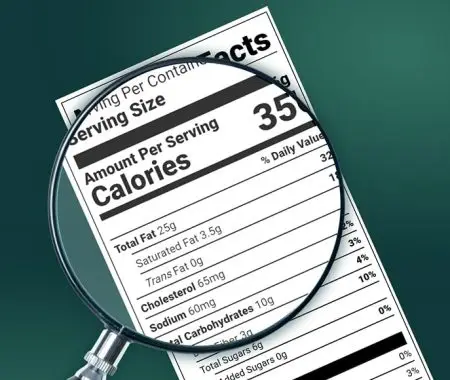
In the competitive landscape of UK food regulations, understanding the requirements for non-prepacked foods – foods sold loose or packaged on the premises for direct sale – has become increasingly crucial. After Brexit, compliance with evolving standards, such as Natasha’s Law, which mandates full ingredient labeling for certain prepacked for direct sale (PPDS) foods, have started to reshape the industry.
For food manufacturers, staying abreast of these regulatory changes is a legal necessity and can be a competitive advantage, as accurate and transparent food labels are a way to steer consumers toward safer and healthier diet choices. While the Food Information Regulations 2014, derived from EU law, still form the backbone of UK food labeling, new UK measures continue to emerge.
Software provided by companies like Food Label Maker can simplify the label making process, ensuring that all mandatory nutrition information is covered, especially for non-prepacked foods. This software helps food businesses adhere to complex legislation, providing accurate and up-to-date labels for various food products in the UK.
Definition and Scope of Non-Prepacked Foods
Non-prepacked foods refer to items sold loose and without manufactured packaging or those packaged at the point of sale based on the consumer’s request. Examples include fresh produce at markets like fruits and vegetables, deli meats purchased over the counter, or ice cream scooped into tubs or cones. Additionally, Prepacked for Direct Sale (PPDS) foods are packaged on the premises where they are sold, an example being a burger at a fast food restaurant.
The distinction between non-prepacked and PPDS foods is crucial. PPDS items must have allergen information on the label, while non-prepacked foods may require detailed allergen information in other formats, like in the form of signage or digital displays. Understanding the differences between these categories and their labelling requirements is vital for food businesses, particularly if you are a mass caterer, so that they meet all relevant requirements when it comes to food labeling.
Regulatory Requirements for Non-Prepacked Foods in the UK
When it comes to non-prepacked foods, UK food businesses must comply with the most up-to-date regulations, as they outline specific requirements to protect consumers. The minimal information that must be provided on the food label includes the following:
- Name of the food: The product must be clearly identifiable.
- Allergen information: Any allergens present in the product must be prominently displayed.
- Meat content declarations (QUID): If a product contains meat, the quantitative ingredient declarations (QUID) must specify the percentage of meat content.
- Irradiated food statements: If any ingredient has been irradiated, this must be clearly stated on the label.
These regulations largely align with European Union law, but post-Brexit developments have introduced these UK-specific nuances that food businesses must navigate carefully. Accuracy in providing this information is crucial, as trading standards bodies rigorously enforce these regulations. Any voluntary information provided must follow the same rules as for prepacked foods, ensuring consistency for consumers.
Allergen Labelling: Natasha’s Law
Natasha’s Law, implemented in October 2021, significantly impacted allergen labelling requirements for Prepacked for Direct Sale (PPDS) foods in the UK. This legislation states that PPDS foods must display a full ingredients list that points out any allergenic ingredients. For non-prepacked foods, while a full ingredients list isn’t required, clear allergen information must still be provided either in writing or verbally upon request.
The emphasis on allergen labelling stems from the need to protect vulnerable consumers with food allergies. For both PPDS and non-prepacked foods, the 14 major allergens must be clearly declared, and this information must be consistent with prepacked food requirements. This means nutrition labels must use clear language, emphasizing allergens typographically (e.g., in bold), and displayed in a way so that the information is visible to consumers.

Special Requirements for Meat and Irradiated Products
Meat products sold as non-prepacked foods require a Quantitative Ingredient Declaration (QUID), which means that there needs to be a clear declaration of meat content percentage. However, there are exemptions to the QUID requirement. Raw meat, for instance, does not require a declaration of meat content percentage. Certain prepared foods like sandwiches, pizzas, and soups are also exempt from this specific requirement, although they must still comply with general labelling and allergen information requirements.
Irradiated foods have strict declaration requirements, necessitating clear labelling as “irradiated” or “treated with ionising radiation”. This is to ensure consumers are fully informed about the processing methods used and it applies to both whole irradiated foods and products containing irradiated ingredients, even if the final product itself was not irradiated.
These special requirements for meat and irradiated products highlight the importance of accurate labelling in the food industry, especially for non-prepacked foods where consumers rely heavily on point-of-sale information.
See How FoodLabelMaker Can Help You
Format and Presentation of Non-Prepacked Foods
While EU Food Information to Consumers (FIC) regulations do not mandate nutrition labelling for non-prepacked foods, there are specific guidelines for manufacturers or businesses voluntarily providing nutrition information. Food businesses can choose to provide this information in one of three formats:
- The full mandatory nutrition declaration (energy, fat, saturates, carbohydrate, sugars, protein, salt)
- Energy value only, or
- Energy + 4 key nutrients (fat, saturates, sugars, and salt).
- The data can be expressed per 100g/ml, per portion, or both. It’s important to note that if a nutrition or health claim is made, nutrition labelling becomes mandatory.
- For energy and four key nutrients, you can display information per portion alone.
This flexibility allows businesses to tailor their nutrition labelling to their food product and customer needs.If your business has agreed to the Responsibility Deal pledge, you should show energy information where customers make a food choice, like on a menu board at a fast food restaurant. Although currently, the UK doesn’t plan to make nutrition labeling mandatory for non prepacked foods.

Methods for Providing Food Information
For non prepacked foods, businesses have three primary methods to communicate essential information to consumers:
- On the product label: When packaging is available, such as for PPDS foods, all required information should be clearly displayed on the label.
- On notices near the product or shelf: For foods sold loose, information can be provided on shelf tags or nearby signs.
- Through verbal communication: Particularly for allergen information, staff can provide information verbally when prompted by clear signage encouraging customers to inquire.
Businesses in stores can use shelf barkers to display nutrition information to consumers. Also known as “shelf talkers” or “shelf shouters”, shelf barkers are small signs attached to store shelves that highlight special deals, provide extra nutritional information, or showcase specific items. By using shelf barkers strategically, store owners or product owners can catch a customer’s eyes while providing clear, transparent information about their food products.
While there’s no minimum font size requirement for non-prepacked foods, the information must still be legible and easily accessible to consumers. Accuracy and consistency across all communication channels are crucial for maintaining consumer trust and meeting legal obligations.
Distance Selling Considerations
In the era of e-commerce and remote ordering, special considerations apply to non-prepacked foods sold through distance selling methods:
- Allergen information must be made available to the consumer before the purchase.
- This can be done through clear listings on the website, in catalogues, or through verbal communication during phone orders.
- Allergen information must be provided at the point of delivery, either in writing (e.g., on packaging or accompanying documentation) or verbally by the delivery person.
- For online platforms, it’s advisable to have a system in place that prompts customers to review allergen information before finalizing their order.
While full ingredient lists may not be mandatory for truly non-prepacked foods sold via distance selling, providing comprehensive information can enhance customer confidence and reduce the risk of dangerous allergic reactions.
By adhering to these guidelines, businesses can ensure they’re meeting their legal obligations and regulatory standards like Natasha’s Law while providing a safe and informed purchasing experience for consumers, regardless of the sales channel.
Consequences of Non-Compliance and Enforcement
Trading Standards play a role in enforcing food information regulations in the UK, and non-compliance with current regulations may lead to serious consequences for food businesses. This includes substantial fines and product recalls, which can also impact your brand’s reputation. Trading Standards officers typically enforce food labelling rules by issuing improvement notices so that companies can correct violations before more severe actions are taken.
However, repeated or serious breaches can even result in legal prosecution. This can have a financial impact on your business as you might have to pay legal fees or lose revenue from recalled products. Additionally, the reputational damage can have long-lasting effects on consumer trust and impact growth for your business in the long run.
To mitigate these risks, businesses in the industry need to stay updated on changing regulations and conduct regular reviews of their labelling practices. This proactive approach ensures compliance and demonstrates a commitment to your consumers’ safety and transparency.
How Food Label Maker’s Software Can Help
Food Label Maker’s software offers comprehensive solutions for creating compliant labels for both non-prepacked and PPDS foods. Key features include:
- Customizable templates that automatically incorporate required information for different food categories.
- Built-in allergen management tools that highlight the 14 major allergens and ensure proper declaration.
- Expert guidance from qualified nutrition experts and options for generating product information on your food labels
- Regular updates to reflect the latest regulatory changes, ensuring ongoing compliance
- User-friendly interface that simplifies the complex task of label creation and reduces the risk of errors
By leveraging these tools, businesses can streamline their labelling processes, enhance accuracy, and maintain compliance with evolving regulations.
Conclusion
In the complicated world of UK food regulations, understanding and adhering to the requirements for non-prepacked foods is essential for businesses. From distinguishing between truly non-prepacked and PPDS foods to ensuring accurate allergen declarations and QUID for meat products, compliance demands attention to detail.
As UK food legislation continues to evolve in the wake of Brexit, staying informed and adaptable to these changes is more important than ever. By prioritizing accurate and detailed food labels, businesses meet legal obligations but also build consumer trust. In food labeling, knowledge and precision are not just regulatory requirements, but they are key ingredients for long-term success in this competitive industry.



